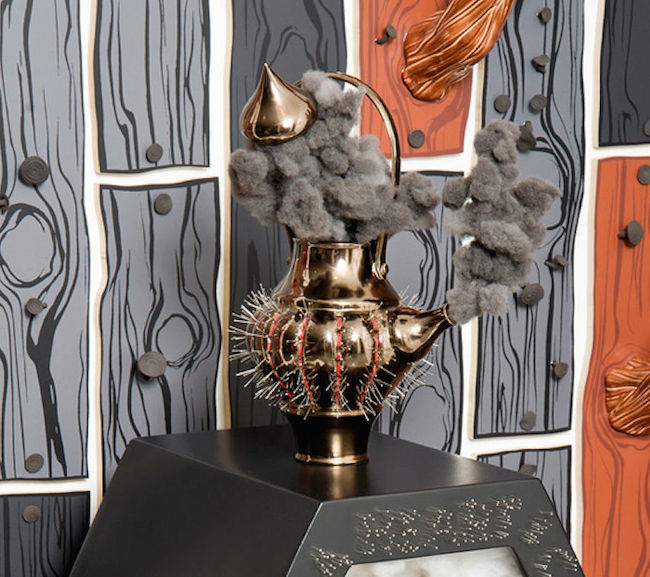Malene Hartmann Rasmussen’s journey from her Thesis show at Royal College of Art in 2011 to winning the Jerwood 2015 Open Prize is remarkable for its unswerving path. In 2011 she stated to Dezeen:
“I try to create a place beyond reality, a deceitful echo of the real world, that bends the perception of what is real. I want my work to look like a very skilled child could have made it, clumsy and elaborate at the same time. Initially the viewer may, mistakenly, be drawn to my figures thinking them to be toys; however closer examination reveals their rather darker narrative. They invite you into an absurd and surreal world where things are not what they seem… A frozen moment that indicate a story and mood but at the same time is open for the viewer to filter their own references through, to make sense and contribute to the story themselves.”
If we take a look at her thesis show and compare that he most recent solo exhibition, one sees that her trajectory is still perfectly on track. In that exhibition, If I Had A Heart I Could Love You, Rassmussen seeks to conjure a surreal series of ceramics in the Brothers Grimm mode centered around a stove full of burning hearts. She states:

“The viewer is intruding this reality-shifting dark place. It is a fake wooden hut, a piece of theater-like scenery made from drawn wood planks, the “Flintstones” aesthetic and Technicolor quality of the ceramics underlines the hyper real dreamlike feeling. In the hut there is a fireplace, the burning logs look like hearts, but the hearts look like real hearts and the branches sticking out of them resembles blood filled arteries and veins. The hut is in a forest or maybe the hut is the forest; the wooden planks are sprouting and coming to life, or maybe they were alive and someone is cutting them down? This uncanny and dark fairytale is fragmented, like in a crime story the clues are scattered around, the viewer is the detective trying to make sense of it all.”
Nightfall her first solo show at Jessica Carlisle in Knightsbridge continues her telling of fairy tales for adults, exploring the theme of the enchanted forest. The following text is by Jessica Carlisle:
“The wild land beyond the cultivated fields has captured our imagination for centuries. The forest as a place of enchantment is a recurring theme in European literature and myth, and can be traced back to primitive man’s awe and fear of nature which gave rise to ancient cults and pagan rituals. In classical mythology, the satyrs and fauns that dwell in the woods act as symbols of bestiality and abandon, whilst in Norse myth the dark Scandinavian forests of Mirk-wood and Iron-Wood are inhabited by elves, trolls, witches and giants, the same creatures that are to be found in 17th & 18th century fairy tales as lore and legend morph into fantasy and fiction.
“The forest continues to act as an important construct in contemporary culture; a sinister backdrop for countless horror movies and novels, it stands as a metaphor for the hidden realms of the unconscious mind.
“Hartmann Rasmussen enters the woods at that most magical time of the day; twilight. It is at this bewitching hour, as daylight fades, that crepuscular creatures emerge from their dens and trees start to talk. This moment of transformation is embedded in Hartmann Rasmussen’s sculptures themselves, the once soft clay now hardened into fragile ceramic.
“Yet these strange creations feel like they might yet become animate. The owl perched on his shelf might at any moment fly away, the stocky rabbit might bound off, and the fronds of wooden hearts be seen to curl and grow. It is these boundaries between living and non-living, animal and human, plant and creature, fact and fiction, and how they have been interpreted and understood over time, that hold such a particular fascination for the artist, and her unique way of exploring and depicting them gives these surreal installations their distinctive uncanny air.”
The work comes alive in Sylvain’s brilliant photography that picks up the crystal clarity of the glazes. However the installation of the work at Jessica Carlysle could hardly have been less imaginative or flattering. Taking the work outside its installation reduces its narrative force.
Garth Clark is the Chief Editor of CFile.
Any thoughts about this post? Share yours in the comment box below.



Malene Hartmann Rasmussen, If I Had a Heart I Could Love You, 2014









Malene Hartmann Rasmussen, works from “Nightfall,” 2014. Photographs by Sylvain Deleu.

Awesome!Love the objects that she has created.